Organizational Behaviour Report: Employee Motivation Analysis
VerifiedAdded on 2023/06/07
|18
|3848
|146
Report
AI Summary
This report delves into the realm of organizational behaviour, focusing on employee motivation within the context of flexible work arrangements. It begins with an executive summary and table of contents, followed by an introduction that highlights the importance of motivation in enhancing employee morale and productivity. The report then identifies flexible work arrangements as a key workplace trend, exploring its various forms and implications for employer-employee relationships. The advantages and disadvantages of flexible work arrangements on employee motivation are considered. The core of the report examines motivational theories, including Maslow's Hierarchy of Needs and Herzberg's Two-Factor Theory, analyzing their strengths, weaknesses, and applicability. The report concludes with three actionable recommendations, grounded in academic literature, for organizations seeking to improve employee motivation. These recommendations are designed to help organizations foster a more engaged and productive workforce by leveraging insights from organizational behaviour.
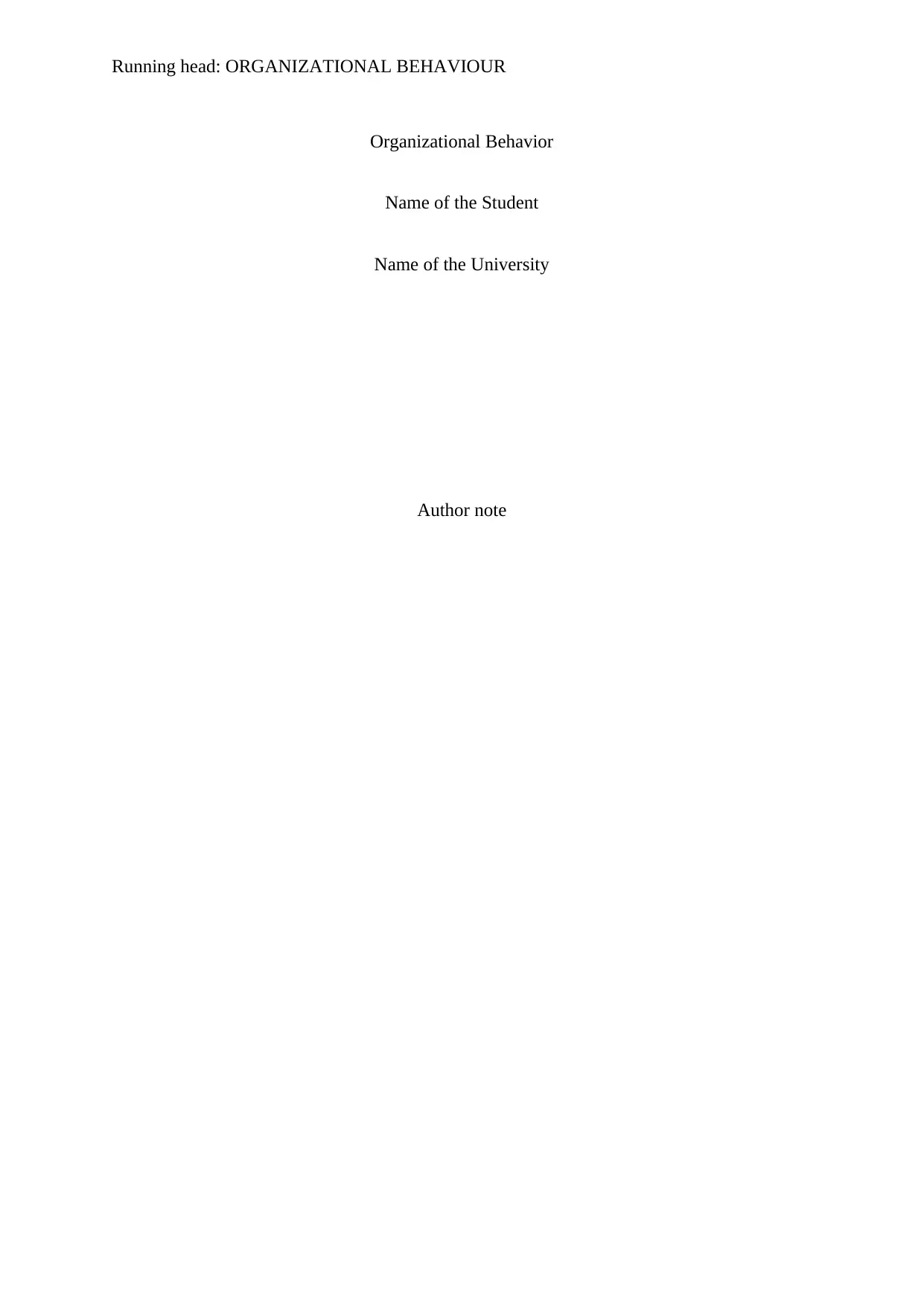
Running head: ORGANIZATIONAL BEHAVIOUR
Organizational Behavior
Name of the Student
Name of the University
Author note
Organizational Behavior
Name of the Student
Name of the University
Author note
Paraphrase This Document
Need a fresh take? Get an instant paraphrase of this document with our AI Paraphraser
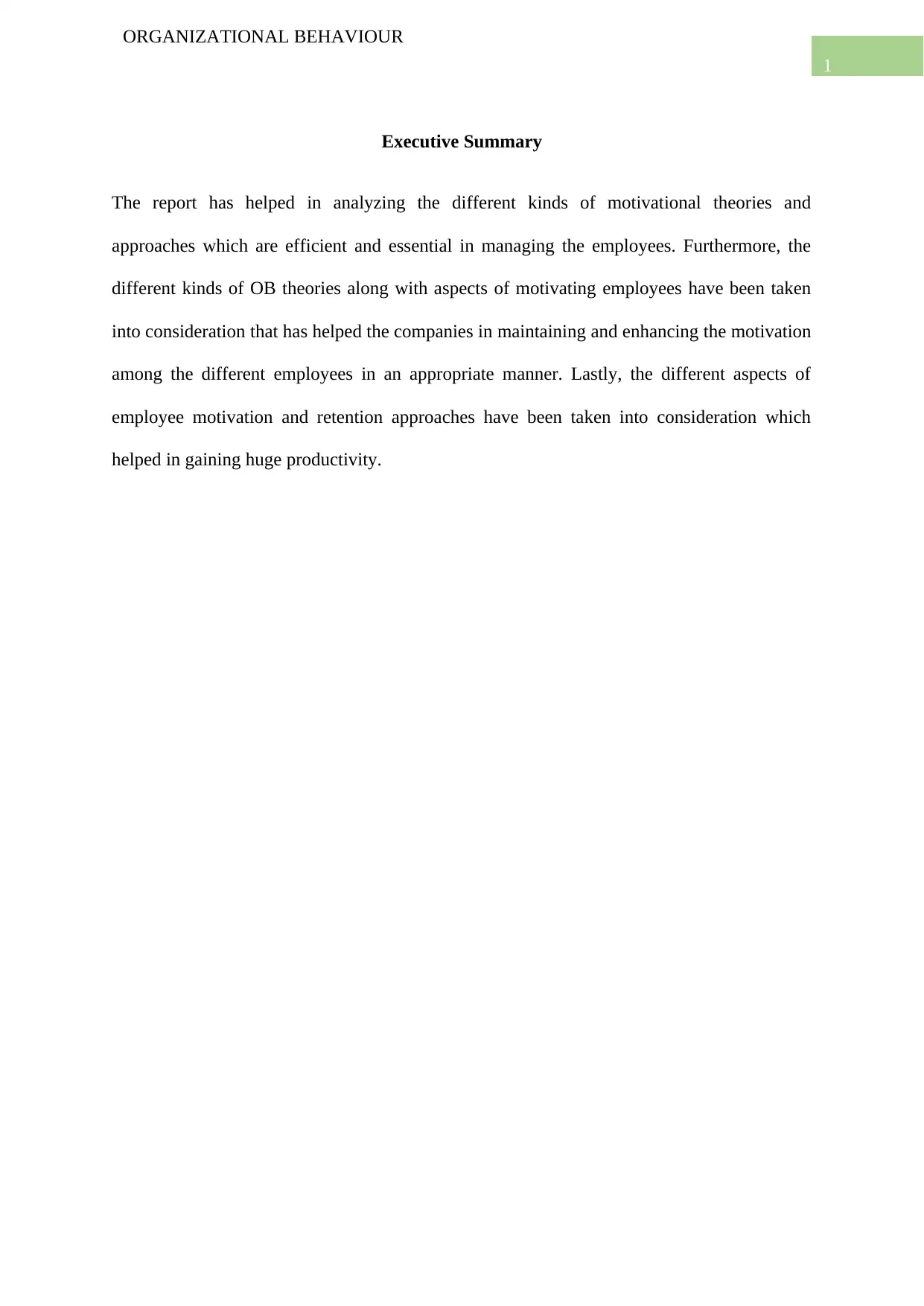
1
ORGANIZATIONAL BEHAVIOUR
Executive Summary
The report has helped in analyzing the different kinds of motivational theories and
approaches which are efficient and essential in managing the employees. Furthermore, the
different kinds of OB theories along with aspects of motivating employees have been taken
into consideration that has helped the companies in maintaining and enhancing the motivation
among the different employees in an appropriate manner. Lastly, the different aspects of
employee motivation and retention approaches have been taken into consideration which
helped in gaining huge productivity.
ORGANIZATIONAL BEHAVIOUR
Executive Summary
The report has helped in analyzing the different kinds of motivational theories and
approaches which are efficient and essential in managing the employees. Furthermore, the
different kinds of OB theories along with aspects of motivating employees have been taken
into consideration that has helped the companies in maintaining and enhancing the motivation
among the different employees in an appropriate manner. Lastly, the different aspects of
employee motivation and retention approaches have been taken into consideration which
helped in gaining huge productivity.
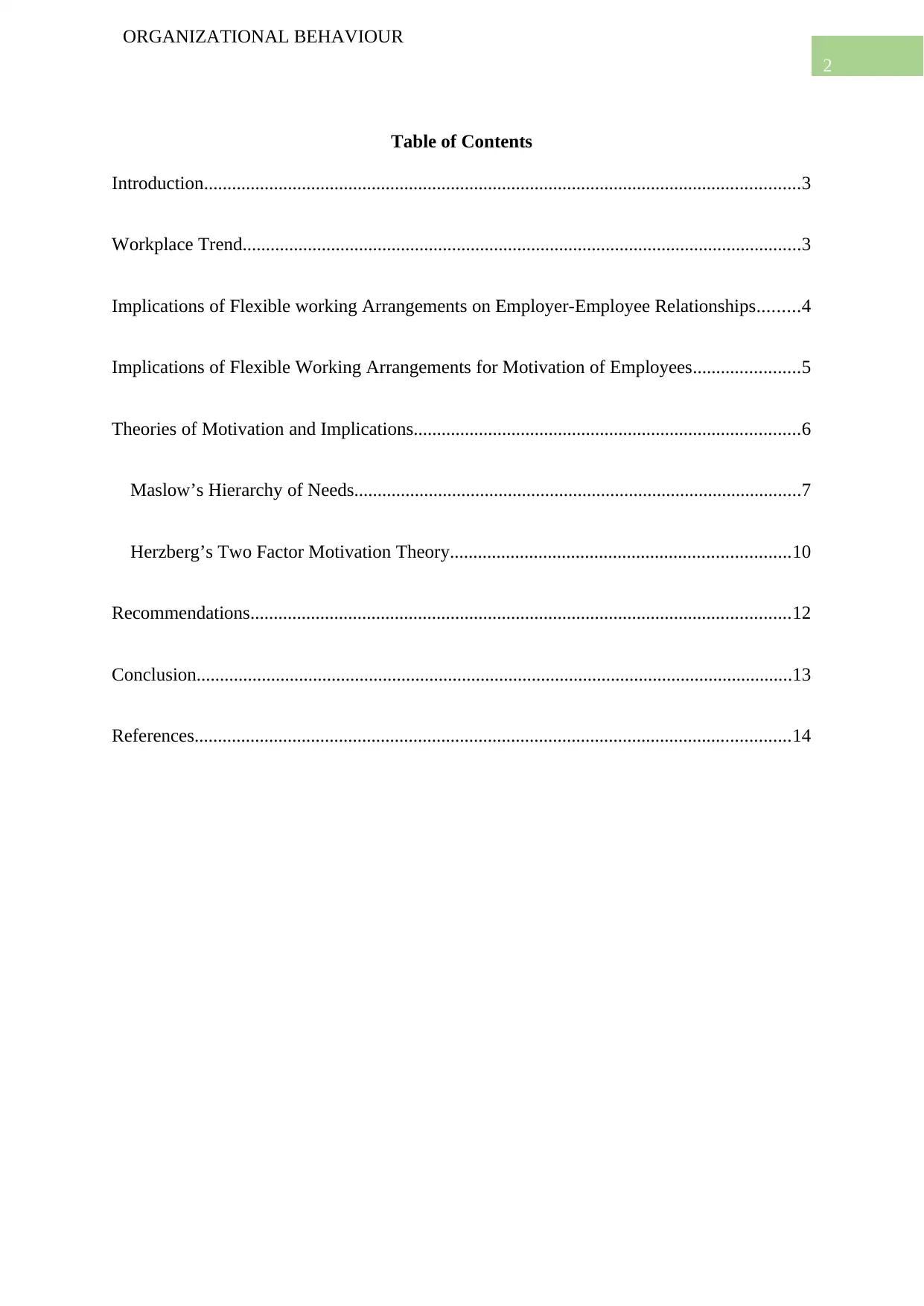
2
ORGANIZATIONAL BEHAVIOUR
Table of Contents
Introduction................................................................................................................................3
Workplace Trend........................................................................................................................3
Implications of Flexible working Arrangements on Employer-Employee Relationships.........4
Implications of Flexible Working Arrangements for Motivation of Employees.......................5
Theories of Motivation and Implications...................................................................................6
Maslow’s Hierarchy of Needs................................................................................................7
Herzberg’s Two Factor Motivation Theory.........................................................................10
Recommendations....................................................................................................................12
Conclusion................................................................................................................................13
References................................................................................................................................14
ORGANIZATIONAL BEHAVIOUR
Table of Contents
Introduction................................................................................................................................3
Workplace Trend........................................................................................................................3
Implications of Flexible working Arrangements on Employer-Employee Relationships.........4
Implications of Flexible Working Arrangements for Motivation of Employees.......................5
Theories of Motivation and Implications...................................................................................6
Maslow’s Hierarchy of Needs................................................................................................7
Herzberg’s Two Factor Motivation Theory.........................................................................10
Recommendations....................................................................................................................12
Conclusion................................................................................................................................13
References................................................................................................................................14
⊘ This is a preview!⊘
Do you want full access?
Subscribe today to unlock all pages.

Trusted by 1+ million students worldwide
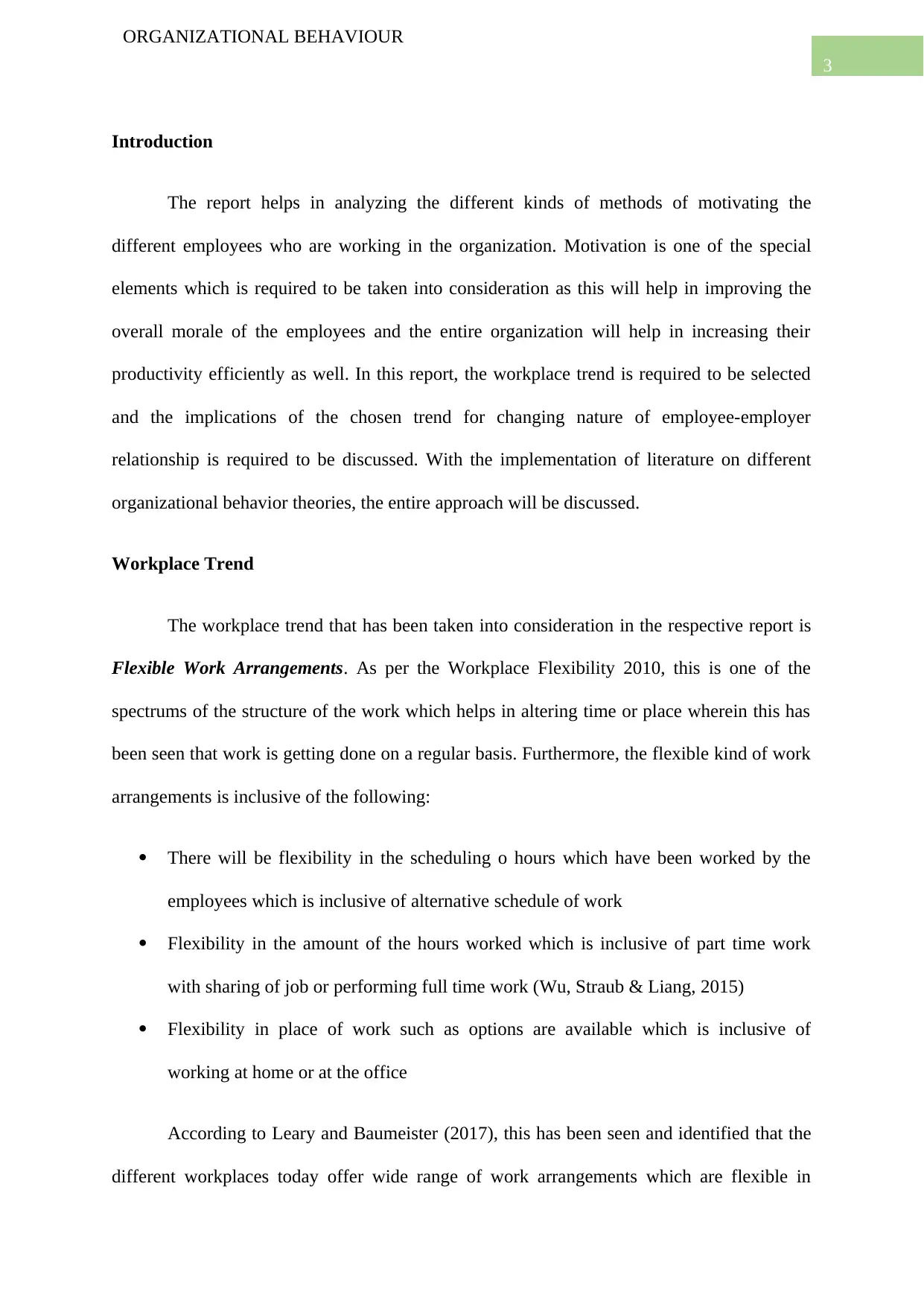
3
ORGANIZATIONAL BEHAVIOUR
Introduction
The report helps in analyzing the different kinds of methods of motivating the
different employees who are working in the organization. Motivation is one of the special
elements which is required to be taken into consideration as this will help in improving the
overall morale of the employees and the entire organization will help in increasing their
productivity efficiently as well. In this report, the workplace trend is required to be selected
and the implications of the chosen trend for changing nature of employee-employer
relationship is required to be discussed. With the implementation of literature on different
organizational behavior theories, the entire approach will be discussed.
Workplace Trend
The workplace trend that has been taken into consideration in the respective report is
Flexible Work Arrangements. As per the Workplace Flexibility 2010, this is one of the
spectrums of the structure of the work which helps in altering time or place wherein this has
been seen that work is getting done on a regular basis. Furthermore, the flexible kind of work
arrangements is inclusive of the following:
There will be flexibility in the scheduling o hours which have been worked by the
employees which is inclusive of alternative schedule of work
Flexibility in the amount of the hours worked which is inclusive of part time work
with sharing of job or performing full time work (Wu, Straub & Liang, 2015)
Flexibility in place of work such as options are available which is inclusive of
working at home or at the office
According to Leary and Baumeister (2017), this has been seen and identified that the
different workplaces today offer wide range of work arrangements which are flexible in
ORGANIZATIONAL BEHAVIOUR
Introduction
The report helps in analyzing the different kinds of methods of motivating the
different employees who are working in the organization. Motivation is one of the special
elements which is required to be taken into consideration as this will help in improving the
overall morale of the employees and the entire organization will help in increasing their
productivity efficiently as well. In this report, the workplace trend is required to be selected
and the implications of the chosen trend for changing nature of employee-employer
relationship is required to be discussed. With the implementation of literature on different
organizational behavior theories, the entire approach will be discussed.
Workplace Trend
The workplace trend that has been taken into consideration in the respective report is
Flexible Work Arrangements. As per the Workplace Flexibility 2010, this is one of the
spectrums of the structure of the work which helps in altering time or place wherein this has
been seen that work is getting done on a regular basis. Furthermore, the flexible kind of work
arrangements is inclusive of the following:
There will be flexibility in the scheduling o hours which have been worked by the
employees which is inclusive of alternative schedule of work
Flexibility in the amount of the hours worked which is inclusive of part time work
with sharing of job or performing full time work (Wu, Straub & Liang, 2015)
Flexibility in place of work such as options are available which is inclusive of
working at home or at the office
According to Leary and Baumeister (2017), this has been seen and identified that the
different workplaces today offer wide range of work arrangements which are flexible in
Paraphrase This Document
Need a fresh take? Get an instant paraphrase of this document with our AI Paraphraser
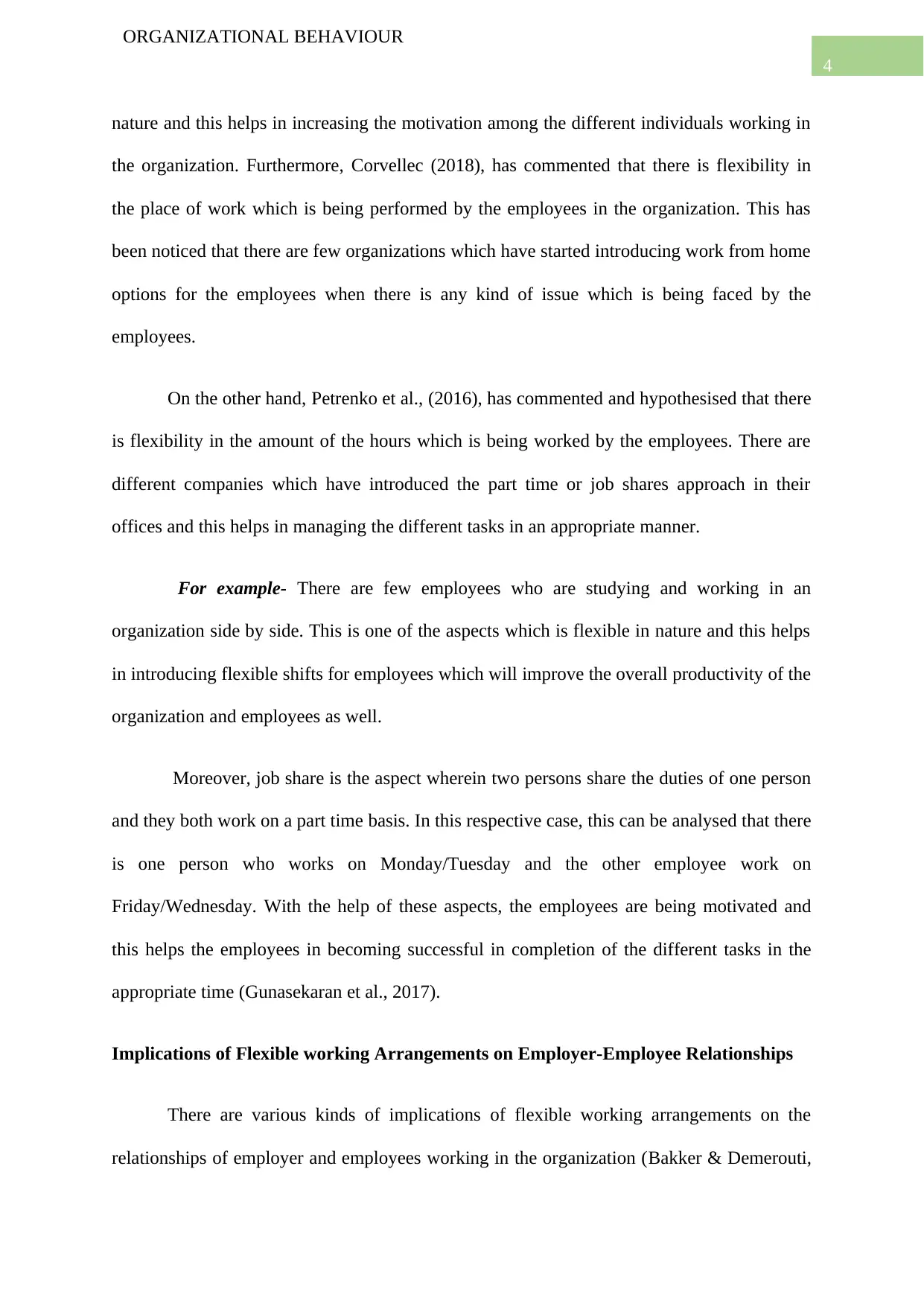
4
ORGANIZATIONAL BEHAVIOUR
nature and this helps in increasing the motivation among the different individuals working in
the organization. Furthermore, Corvellec (2018), has commented that there is flexibility in
the place of work which is being performed by the employees in the organization. This has
been noticed that there are few organizations which have started introducing work from home
options for the employees when there is any kind of issue which is being faced by the
employees.
On the other hand, Petrenko et al., (2016), has commented and hypothesised that there
is flexibility in the amount of the hours which is being worked by the employees. There are
different companies which have introduced the part time or job shares approach in their
offices and this helps in managing the different tasks in an appropriate manner.
For example- There are few employees who are studying and working in an
organization side by side. This is one of the aspects which is flexible in nature and this helps
in introducing flexible shifts for employees which will improve the overall productivity of the
organization and employees as well.
Moreover, job share is the aspect wherein two persons share the duties of one person
and they both work on a part time basis. In this respective case, this can be analysed that there
is one person who works on Monday/Tuesday and the other employee work on
Friday/Wednesday. With the help of these aspects, the employees are being motivated and
this helps the employees in becoming successful in completion of the different tasks in the
appropriate time (Gunasekaran et al., 2017).
Implications of Flexible working Arrangements on Employer-Employee Relationships
There are various kinds of implications of flexible working arrangements on the
relationships of employer and employees working in the organization (Bakker & Demerouti,
ORGANIZATIONAL BEHAVIOUR
nature and this helps in increasing the motivation among the different individuals working in
the organization. Furthermore, Corvellec (2018), has commented that there is flexibility in
the place of work which is being performed by the employees in the organization. This has
been noticed that there are few organizations which have started introducing work from home
options for the employees when there is any kind of issue which is being faced by the
employees.
On the other hand, Petrenko et al., (2016), has commented and hypothesised that there
is flexibility in the amount of the hours which is being worked by the employees. There are
different companies which have introduced the part time or job shares approach in their
offices and this helps in managing the different tasks in an appropriate manner.
For example- There are few employees who are studying and working in an
organization side by side. This is one of the aspects which is flexible in nature and this helps
in introducing flexible shifts for employees which will improve the overall productivity of the
organization and employees as well.
Moreover, job share is the aspect wherein two persons share the duties of one person
and they both work on a part time basis. In this respective case, this can be analysed that there
is one person who works on Monday/Tuesday and the other employee work on
Friday/Wednesday. With the help of these aspects, the employees are being motivated and
this helps the employees in becoming successful in completion of the different tasks in the
appropriate time (Gunasekaran et al., 2017).
Implications of Flexible working Arrangements on Employer-Employee Relationships
There are various kinds of implications of flexible working arrangements on the
relationships of employer and employees working in the organization (Bakker & Demerouti,
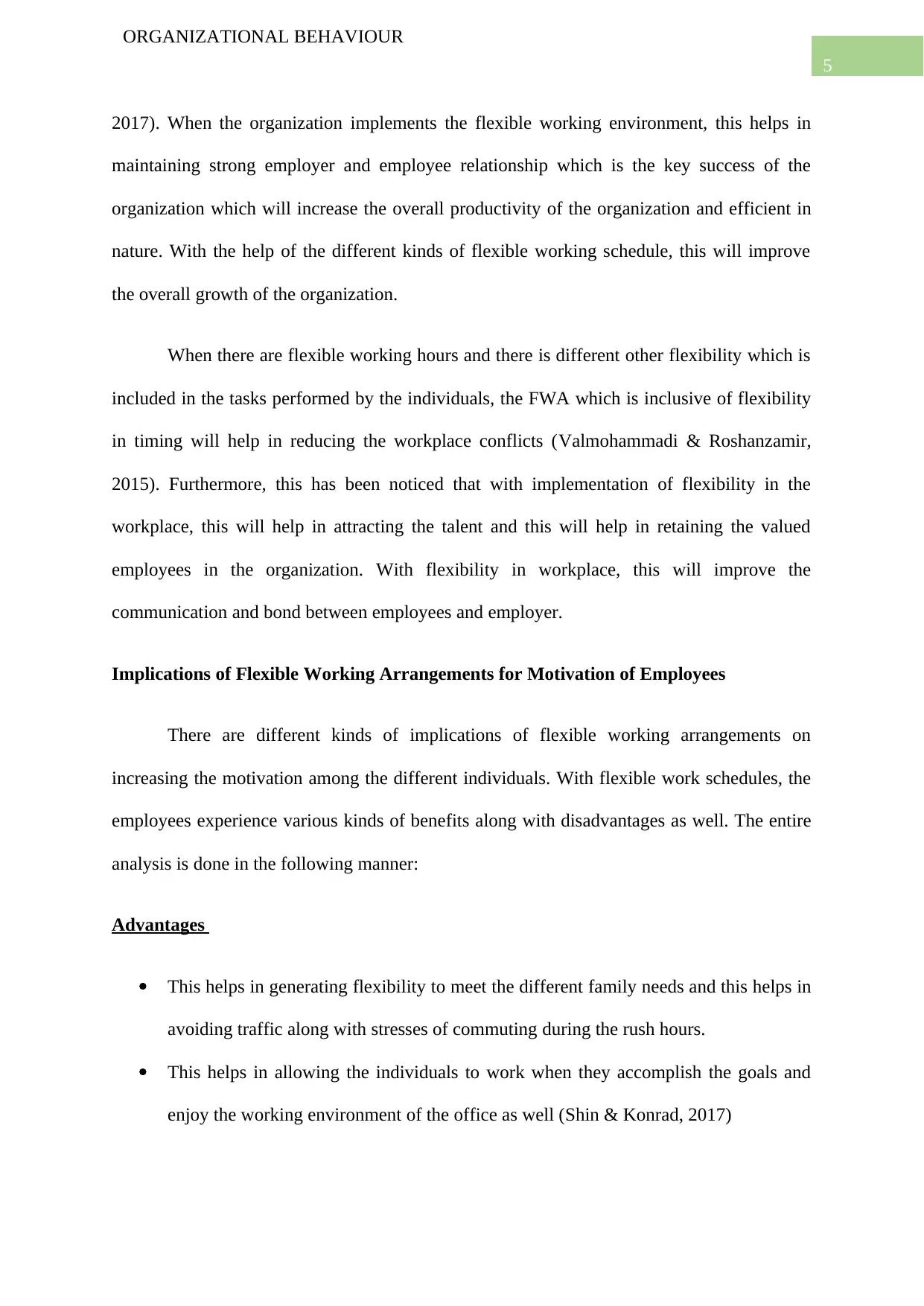
5
ORGANIZATIONAL BEHAVIOUR
2017). When the organization implements the flexible working environment, this helps in
maintaining strong employer and employee relationship which is the key success of the
organization which will increase the overall productivity of the organization and efficient in
nature. With the help of the different kinds of flexible working schedule, this will improve
the overall growth of the organization.
When there are flexible working hours and there is different other flexibility which is
included in the tasks performed by the individuals, the FWA which is inclusive of flexibility
in timing will help in reducing the workplace conflicts (Valmohammadi & Roshanzamir,
2015). Furthermore, this has been noticed that with implementation of flexibility in the
workplace, this will help in attracting the talent and this will help in retaining the valued
employees in the organization. With flexibility in workplace, this will improve the
communication and bond between employees and employer.
Implications of Flexible Working Arrangements for Motivation of Employees
There are different kinds of implications of flexible working arrangements on
increasing the motivation among the different individuals. With flexible work schedules, the
employees experience various kinds of benefits along with disadvantages as well. The entire
analysis is done in the following manner:
Advantages
This helps in generating flexibility to meet the different family needs and this helps in
avoiding traffic along with stresses of commuting during the rush hours.
This helps in allowing the individuals to work when they accomplish the goals and
enjoy the working environment of the office as well (Shin & Konrad, 2017)
ORGANIZATIONAL BEHAVIOUR
2017). When the organization implements the flexible working environment, this helps in
maintaining strong employer and employee relationship which is the key success of the
organization which will increase the overall productivity of the organization and efficient in
nature. With the help of the different kinds of flexible working schedule, this will improve
the overall growth of the organization.
When there are flexible working hours and there is different other flexibility which is
included in the tasks performed by the individuals, the FWA which is inclusive of flexibility
in timing will help in reducing the workplace conflicts (Valmohammadi & Roshanzamir,
2015). Furthermore, this has been noticed that with implementation of flexibility in the
workplace, this will help in attracting the talent and this will help in retaining the valued
employees in the organization. With flexibility in workplace, this will improve the
communication and bond between employees and employer.
Implications of Flexible Working Arrangements for Motivation of Employees
There are different kinds of implications of flexible working arrangements on
increasing the motivation among the different individuals. With flexible work schedules, the
employees experience various kinds of benefits along with disadvantages as well. The entire
analysis is done in the following manner:
Advantages
This helps in generating flexibility to meet the different family needs and this helps in
avoiding traffic along with stresses of commuting during the rush hours.
This helps in allowing the individuals to work when they accomplish the goals and
enjoy the working environment of the office as well (Shin & Konrad, 2017)
⊘ This is a preview!⊘
Do you want full access?
Subscribe today to unlock all pages.

Trusted by 1+ million students worldwide
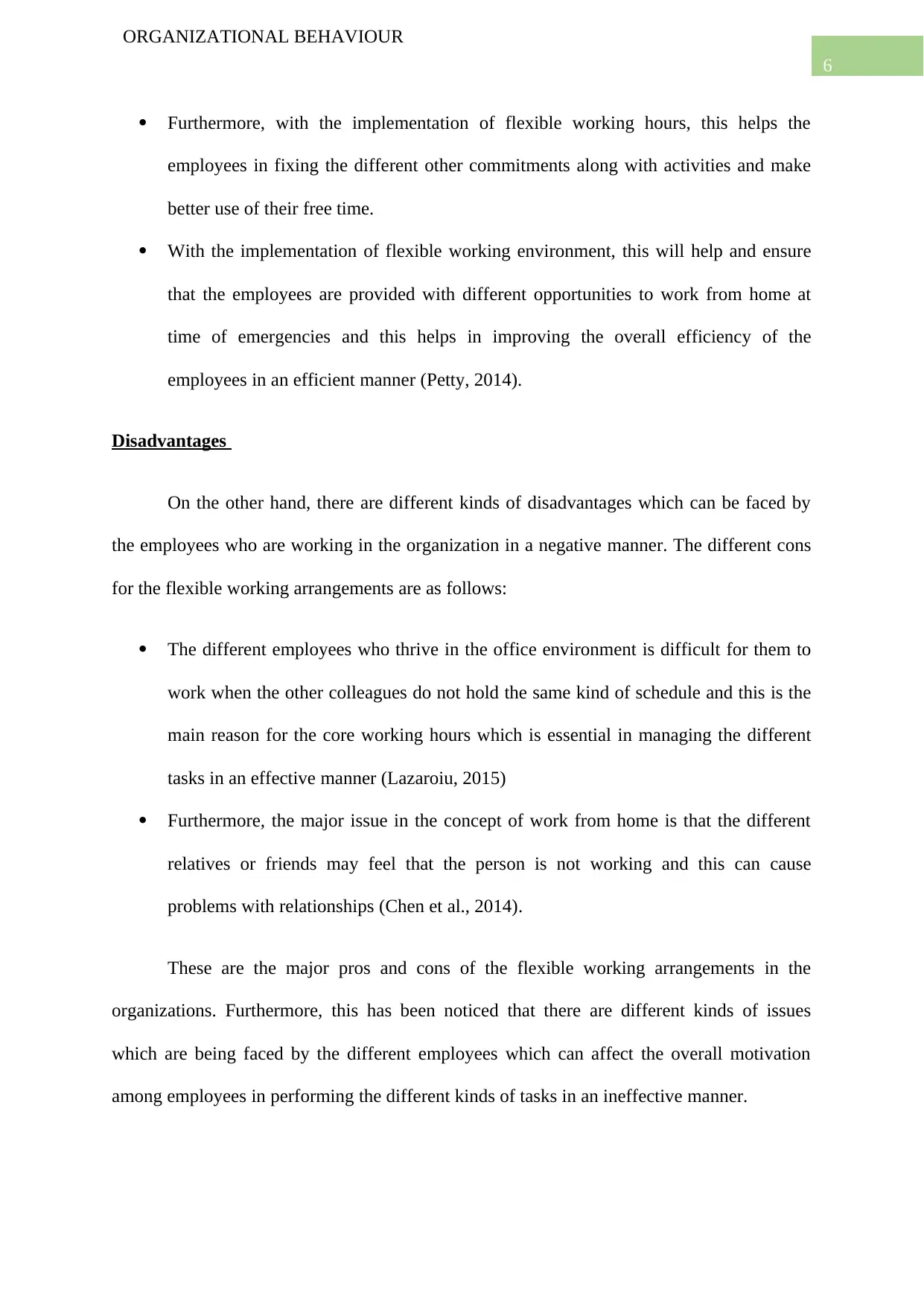
6
ORGANIZATIONAL BEHAVIOUR
Furthermore, with the implementation of flexible working hours, this helps the
employees in fixing the different other commitments along with activities and make
better use of their free time.
With the implementation of flexible working environment, this will help and ensure
that the employees are provided with different opportunities to work from home at
time of emergencies and this helps in improving the overall efficiency of the
employees in an efficient manner (Petty, 2014).
Disadvantages
On the other hand, there are different kinds of disadvantages which can be faced by
the employees who are working in the organization in a negative manner. The different cons
for the flexible working arrangements are as follows:
The different employees who thrive in the office environment is difficult for them to
work when the other colleagues do not hold the same kind of schedule and this is the
main reason for the core working hours which is essential in managing the different
tasks in an effective manner (Lazaroiu, 2015)
Furthermore, the major issue in the concept of work from home is that the different
relatives or friends may feel that the person is not working and this can cause
problems with relationships (Chen et al., 2014).
These are the major pros and cons of the flexible working arrangements in the
organizations. Furthermore, this has been noticed that there are different kinds of issues
which are being faced by the different employees which can affect the overall motivation
among employees in performing the different kinds of tasks in an ineffective manner.
ORGANIZATIONAL BEHAVIOUR
Furthermore, with the implementation of flexible working hours, this helps the
employees in fixing the different other commitments along with activities and make
better use of their free time.
With the implementation of flexible working environment, this will help and ensure
that the employees are provided with different opportunities to work from home at
time of emergencies and this helps in improving the overall efficiency of the
employees in an efficient manner (Petty, 2014).
Disadvantages
On the other hand, there are different kinds of disadvantages which can be faced by
the employees who are working in the organization in a negative manner. The different cons
for the flexible working arrangements are as follows:
The different employees who thrive in the office environment is difficult for them to
work when the other colleagues do not hold the same kind of schedule and this is the
main reason for the core working hours which is essential in managing the different
tasks in an effective manner (Lazaroiu, 2015)
Furthermore, the major issue in the concept of work from home is that the different
relatives or friends may feel that the person is not working and this can cause
problems with relationships (Chen et al., 2014).
These are the major pros and cons of the flexible working arrangements in the
organizations. Furthermore, this has been noticed that there are different kinds of issues
which are being faced by the different employees which can affect the overall motivation
among employees in performing the different kinds of tasks in an ineffective manner.
Paraphrase This Document
Need a fresh take? Get an instant paraphrase of this document with our AI Paraphraser
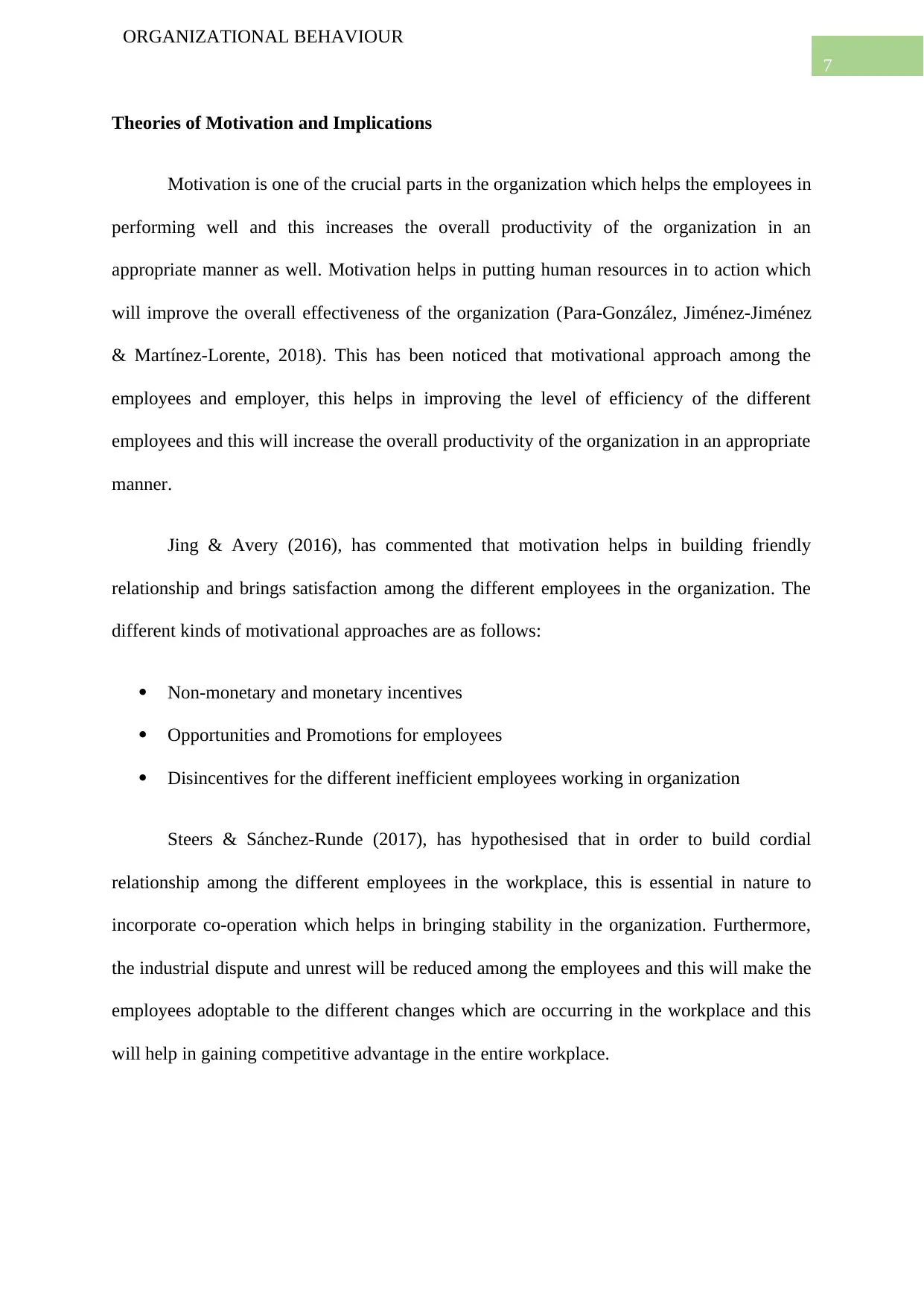
7
ORGANIZATIONAL BEHAVIOUR
Theories of Motivation and Implications
Motivation is one of the crucial parts in the organization which helps the employees in
performing well and this increases the overall productivity of the organization in an
appropriate manner as well. Motivation helps in putting human resources in to action which
will improve the overall effectiveness of the organization (Para-González, Jiménez-Jiménez
& Martínez-Lorente, 2018). This has been noticed that motivational approach among the
employees and employer, this helps in improving the level of efficiency of the different
employees and this will increase the overall productivity of the organization in an appropriate
manner.
Jing & Avery (2016), has commented that motivation helps in building friendly
relationship and brings satisfaction among the different employees in the organization. The
different kinds of motivational approaches are as follows:
Non-monetary and monetary incentives
Opportunities and Promotions for employees
Disincentives for the different inefficient employees working in organization
Steers & Sánchez‐Runde (2017), has hypothesised that in order to build cordial
relationship among the different employees in the workplace, this is essential in nature to
incorporate co-operation which helps in bringing stability in the organization. Furthermore,
the industrial dispute and unrest will be reduced among the employees and this will make the
employees adoptable to the different changes which are occurring in the workplace and this
will help in gaining competitive advantage in the entire workplace.
ORGANIZATIONAL BEHAVIOUR
Theories of Motivation and Implications
Motivation is one of the crucial parts in the organization which helps the employees in
performing well and this increases the overall productivity of the organization in an
appropriate manner as well. Motivation helps in putting human resources in to action which
will improve the overall effectiveness of the organization (Para-González, Jiménez-Jiménez
& Martínez-Lorente, 2018). This has been noticed that motivational approach among the
employees and employer, this helps in improving the level of efficiency of the different
employees and this will increase the overall productivity of the organization in an appropriate
manner.
Jing & Avery (2016), has commented that motivation helps in building friendly
relationship and brings satisfaction among the different employees in the organization. The
different kinds of motivational approaches are as follows:
Non-monetary and monetary incentives
Opportunities and Promotions for employees
Disincentives for the different inefficient employees working in organization
Steers & Sánchez‐Runde (2017), has hypothesised that in order to build cordial
relationship among the different employees in the workplace, this is essential in nature to
incorporate co-operation which helps in bringing stability in the organization. Furthermore,
the industrial dispute and unrest will be reduced among the employees and this will make the
employees adoptable to the different changes which are occurring in the workplace and this
will help in gaining competitive advantage in the entire workplace.
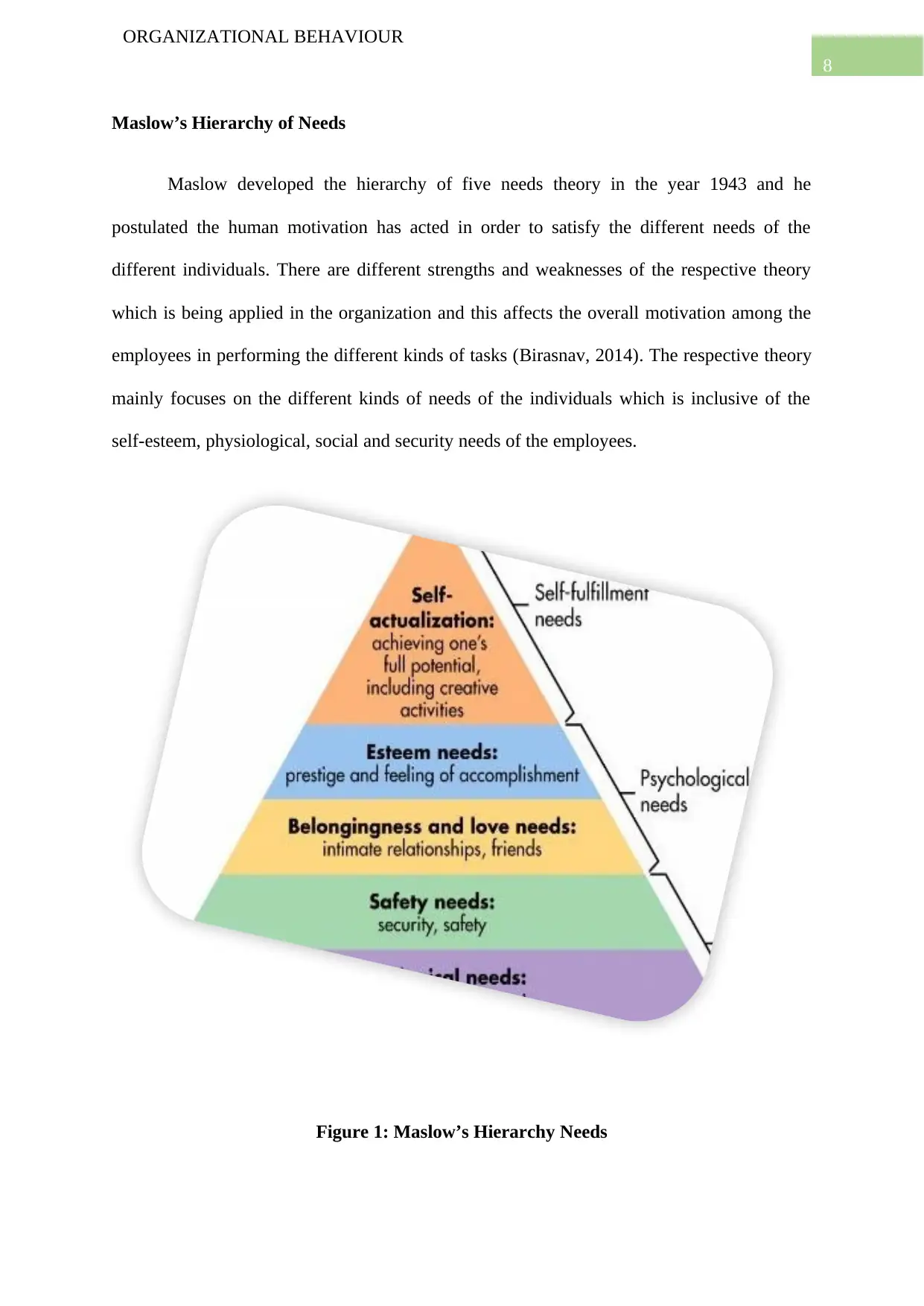
8
ORGANIZATIONAL BEHAVIOUR
Maslow’s Hierarchy of Needs
Maslow developed the hierarchy of five needs theory in the year 1943 and he
postulated the human motivation has acted in order to satisfy the different needs of the
different individuals. There are different strengths and weaknesses of the respective theory
which is being applied in the organization and this affects the overall motivation among the
employees in performing the different kinds of tasks (Birasnav, 2014). The respective theory
mainly focuses on the different kinds of needs of the individuals which is inclusive of the
self-esteem, physiological, social and security needs of the employees.
Figure 1: Maslow’s Hierarchy Needs
ORGANIZATIONAL BEHAVIOUR
Maslow’s Hierarchy of Needs
Maslow developed the hierarchy of five needs theory in the year 1943 and he
postulated the human motivation has acted in order to satisfy the different needs of the
different individuals. There are different strengths and weaknesses of the respective theory
which is being applied in the organization and this affects the overall motivation among the
employees in performing the different kinds of tasks (Birasnav, 2014). The respective theory
mainly focuses on the different kinds of needs of the individuals which is inclusive of the
self-esteem, physiological, social and security needs of the employees.
Figure 1: Maslow’s Hierarchy Needs
⊘ This is a preview!⊘
Do you want full access?
Subscribe today to unlock all pages.

Trusted by 1+ million students worldwide
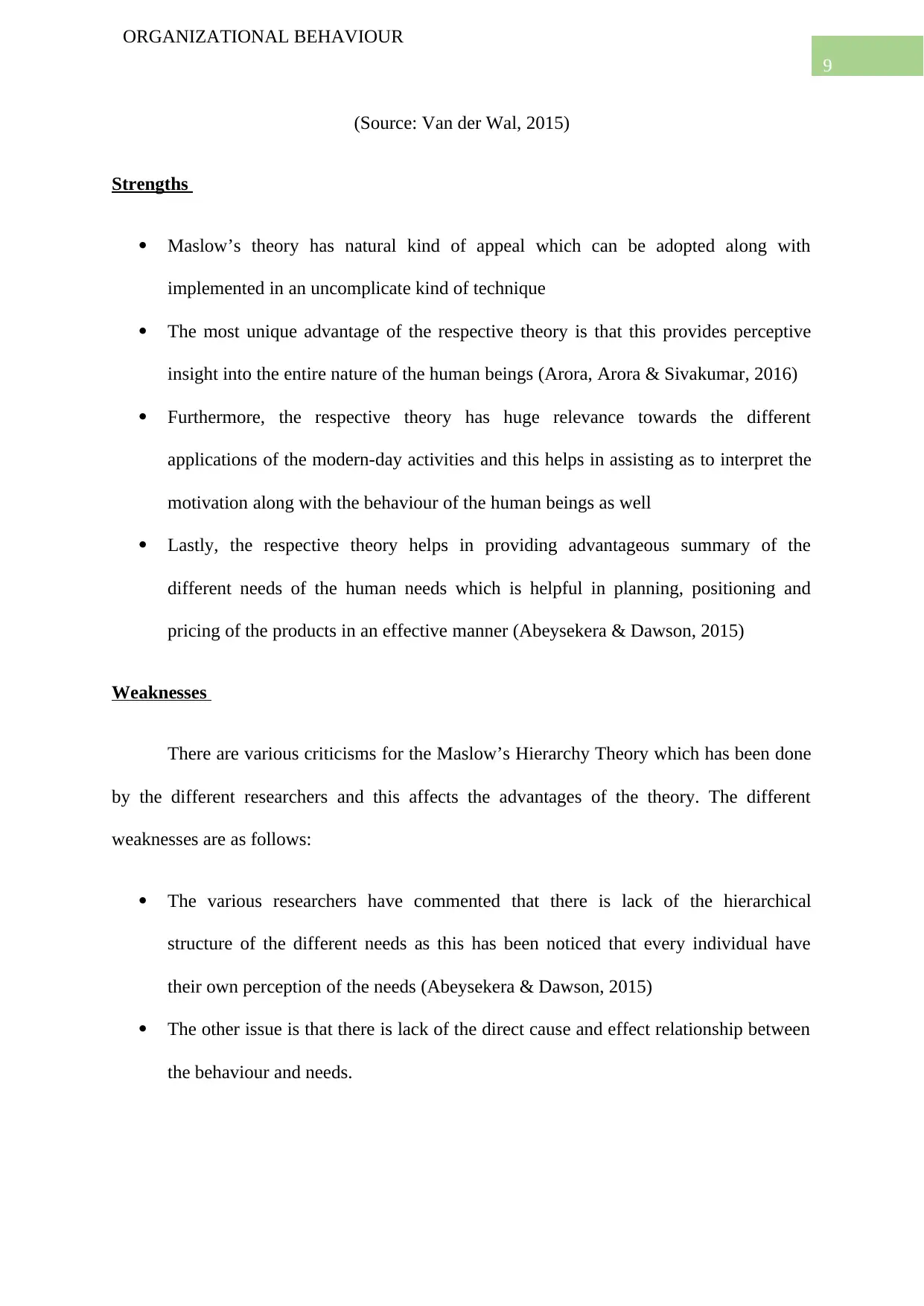
9
ORGANIZATIONAL BEHAVIOUR
(Source: Van der Wal, 2015)
Strengths
Maslow’s theory has natural kind of appeal which can be adopted along with
implemented in an uncomplicate kind of technique
The most unique advantage of the respective theory is that this provides perceptive
insight into the entire nature of the human beings (Arora, Arora & Sivakumar, 2016)
Furthermore, the respective theory has huge relevance towards the different
applications of the modern-day activities and this helps in assisting as to interpret the
motivation along with the behaviour of the human beings as well
Lastly, the respective theory helps in providing advantageous summary of the
different needs of the human needs which is helpful in planning, positioning and
pricing of the products in an effective manner (Abeysekera & Dawson, 2015)
Weaknesses
There are various criticisms for the Maslow’s Hierarchy Theory which has been done
by the different researchers and this affects the advantages of the theory. The different
weaknesses are as follows:
The various researchers have commented that there is lack of the hierarchical
structure of the different needs as this has been noticed that every individual have
their own perception of the needs (Abeysekera & Dawson, 2015)
The other issue is that there is lack of the direct cause and effect relationship between
the behaviour and needs.
ORGANIZATIONAL BEHAVIOUR
(Source: Van der Wal, 2015)
Strengths
Maslow’s theory has natural kind of appeal which can be adopted along with
implemented in an uncomplicate kind of technique
The most unique advantage of the respective theory is that this provides perceptive
insight into the entire nature of the human beings (Arora, Arora & Sivakumar, 2016)
Furthermore, the respective theory has huge relevance towards the different
applications of the modern-day activities and this helps in assisting as to interpret the
motivation along with the behaviour of the human beings as well
Lastly, the respective theory helps in providing advantageous summary of the
different needs of the human needs which is helpful in planning, positioning and
pricing of the products in an effective manner (Abeysekera & Dawson, 2015)
Weaknesses
There are various criticisms for the Maslow’s Hierarchy Theory which has been done
by the different researchers and this affects the advantages of the theory. The different
weaknesses are as follows:
The various researchers have commented that there is lack of the hierarchical
structure of the different needs as this has been noticed that every individual have
their own perception of the needs (Abeysekera & Dawson, 2015)
The other issue is that there is lack of the direct cause and effect relationship between
the behaviour and needs.
Paraphrase This Document
Need a fresh take? Get an instant paraphrase of this document with our AI Paraphraser
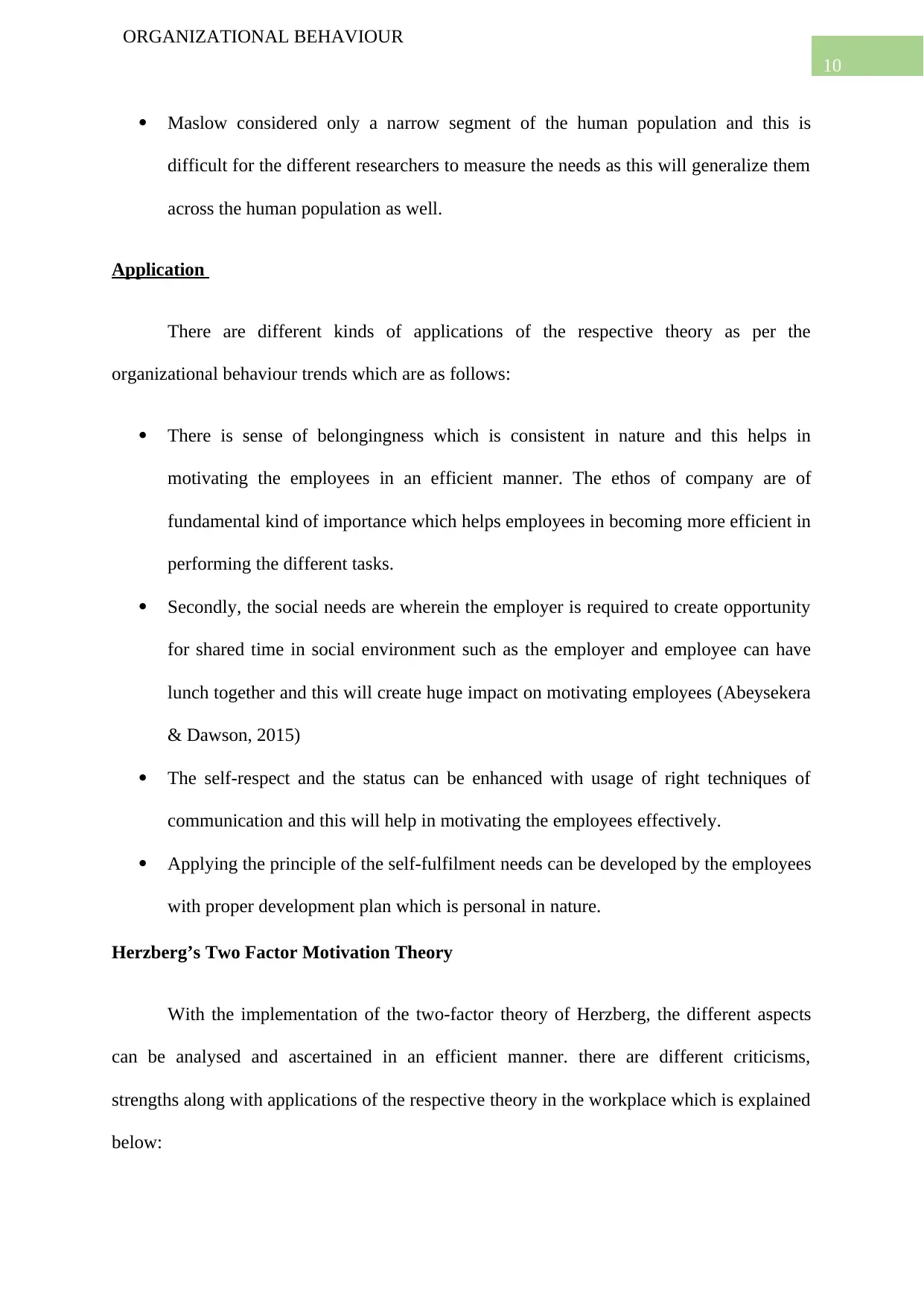
10
ORGANIZATIONAL BEHAVIOUR
Maslow considered only a narrow segment of the human population and this is
difficult for the different researchers to measure the needs as this will generalize them
across the human population as well.
Application
There are different kinds of applications of the respective theory as per the
organizational behaviour trends which are as follows:
There is sense of belongingness which is consistent in nature and this helps in
motivating the employees in an efficient manner. The ethos of company are of
fundamental kind of importance which helps employees in becoming more efficient in
performing the different tasks.
Secondly, the social needs are wherein the employer is required to create opportunity
for shared time in social environment such as the employer and employee can have
lunch together and this will create huge impact on motivating employees (Abeysekera
& Dawson, 2015)
The self-respect and the status can be enhanced with usage of right techniques of
communication and this will help in motivating the employees effectively.
Applying the principle of the self-fulfilment needs can be developed by the employees
with proper development plan which is personal in nature.
Herzberg’s Two Factor Motivation Theory
With the implementation of the two-factor theory of Herzberg, the different aspects
can be analysed and ascertained in an efficient manner. there are different criticisms,
strengths along with applications of the respective theory in the workplace which is explained
below:
ORGANIZATIONAL BEHAVIOUR
Maslow considered only a narrow segment of the human population and this is
difficult for the different researchers to measure the needs as this will generalize them
across the human population as well.
Application
There are different kinds of applications of the respective theory as per the
organizational behaviour trends which are as follows:
There is sense of belongingness which is consistent in nature and this helps in
motivating the employees in an efficient manner. The ethos of company are of
fundamental kind of importance which helps employees in becoming more efficient in
performing the different tasks.
Secondly, the social needs are wherein the employer is required to create opportunity
for shared time in social environment such as the employer and employee can have
lunch together and this will create huge impact on motivating employees (Abeysekera
& Dawson, 2015)
The self-respect and the status can be enhanced with usage of right techniques of
communication and this will help in motivating the employees effectively.
Applying the principle of the self-fulfilment needs can be developed by the employees
with proper development plan which is personal in nature.
Herzberg’s Two Factor Motivation Theory
With the implementation of the two-factor theory of Herzberg, the different aspects
can be analysed and ascertained in an efficient manner. there are different criticisms,
strengths along with applications of the respective theory in the workplace which is explained
below:
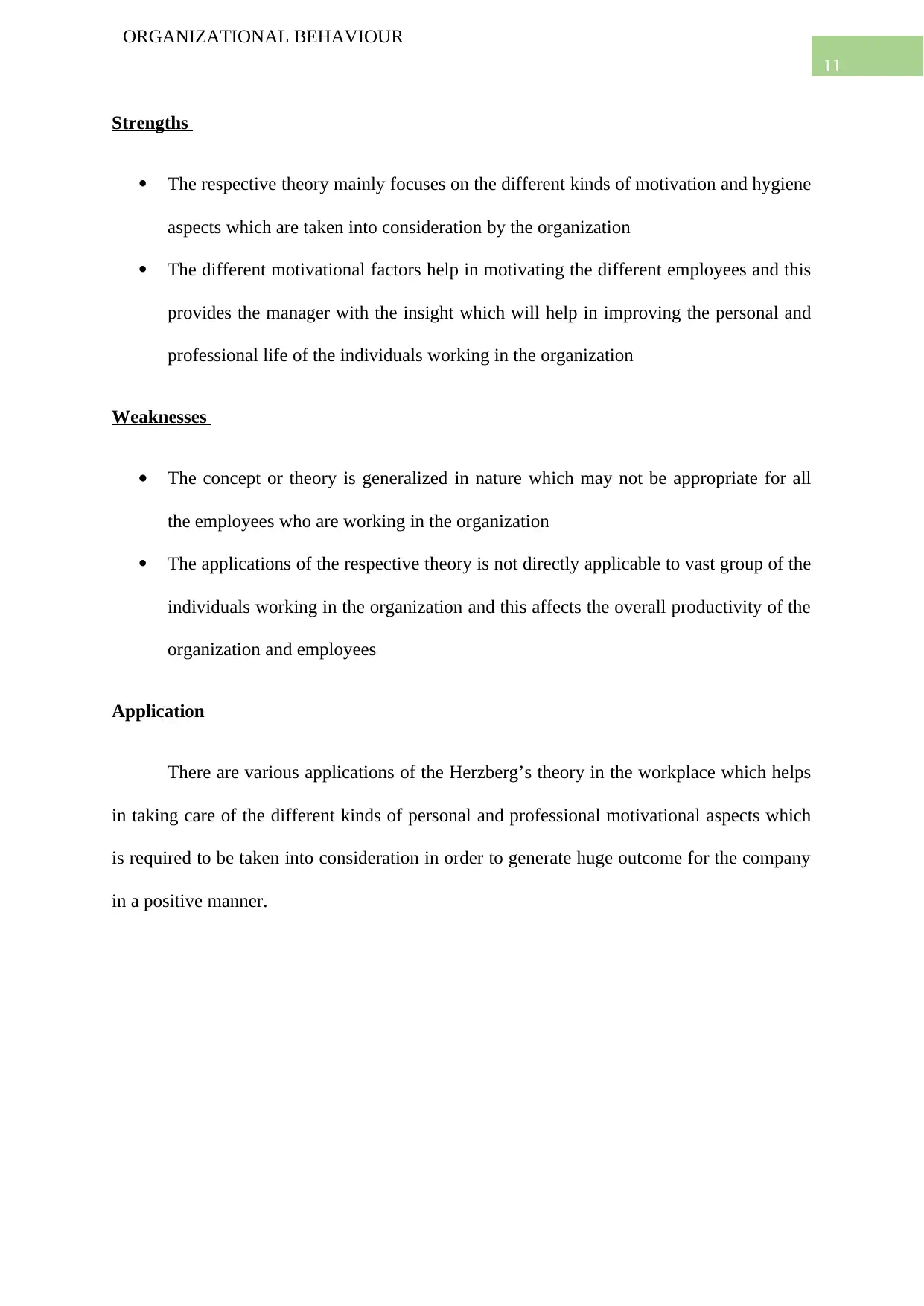
11
ORGANIZATIONAL BEHAVIOUR
Strengths
The respective theory mainly focuses on the different kinds of motivation and hygiene
aspects which are taken into consideration by the organization
The different motivational factors help in motivating the different employees and this
provides the manager with the insight which will help in improving the personal and
professional life of the individuals working in the organization
Weaknesses
The concept or theory is generalized in nature which may not be appropriate for all
the employees who are working in the organization
The applications of the respective theory is not directly applicable to vast group of the
individuals working in the organization and this affects the overall productivity of the
organization and employees
Application
There are various applications of the Herzberg’s theory in the workplace which helps
in taking care of the different kinds of personal and professional motivational aspects which
is required to be taken into consideration in order to generate huge outcome for the company
in a positive manner.
ORGANIZATIONAL BEHAVIOUR
Strengths
The respective theory mainly focuses on the different kinds of motivation and hygiene
aspects which are taken into consideration by the organization
The different motivational factors help in motivating the different employees and this
provides the manager with the insight which will help in improving the personal and
professional life of the individuals working in the organization
Weaknesses
The concept or theory is generalized in nature which may not be appropriate for all
the employees who are working in the organization
The applications of the respective theory is not directly applicable to vast group of the
individuals working in the organization and this affects the overall productivity of the
organization and employees
Application
There are various applications of the Herzberg’s theory in the workplace which helps
in taking care of the different kinds of personal and professional motivational aspects which
is required to be taken into consideration in order to generate huge outcome for the company
in a positive manner.
⊘ This is a preview!⊘
Do you want full access?
Subscribe today to unlock all pages.

Trusted by 1+ million students worldwide
1 out of 18
Related Documents
Your All-in-One AI-Powered Toolkit for Academic Success.
+13062052269
info@desklib.com
Available 24*7 on WhatsApp / Email
![[object Object]](/_next/static/media/star-bottom.7253800d.svg)
Unlock your academic potential
Copyright © 2020–2025 A2Z Services. All Rights Reserved. Developed and managed by ZUCOL.





